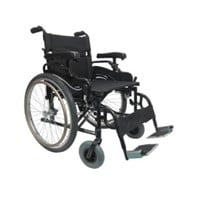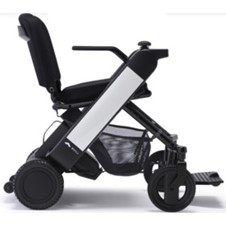Being a wheelchair user is not easy, it’s tough getting around with the help of a wheelchair but you also have to take care of it. For people with a lack of mobility, a wheelchair is like an extension of their own body and as you take care of your body you have to take care of your wheelchair too. Regular cleaning and disinfection not only help to prolong the lifespan of your wheelchair but also contribute to your overall health and well-being. In today’s world, where infectious diseases are a concern, proper wheelchair cleaning and disinfection are more important than ever.
In this comprehensive guide Cura360 we will provide you with valuable information and practical tips on how to effectively clean and disinfect your wheelchair. Whether you are a wheelchair user, a caregiver, or a healthcare professional, this guide will equip you with the knowledge and techniques needed to maintain a clean and germ-free wheelchair environment.
By implementing proper cleaning and disinfection protocols, you can create a safe and hygienic wheelchair environment, reducing the risk of infection and promoting optimal health for wheelchair users.
Cleaning Vs Disinfecting
Some may think that cleaning the wheelchair or disinfecting the wheelchair is the same but that’s just half true. We have to understand this by first understanding the difference between cleaning and disinfecting.
Cleaning and disinfecting are two distinct processes that play important roles in maintaining a clean and germ-free environment. Cleaning involves removing dirt, debris, and visible contaminants from surfaces, typically using soap, water, and physical scrubbing. It helps to reduce the number of germs on surfaces but may not eliminate all pathogens.
On the other hand, disinfecting involves using chemicals or antimicrobial agents to kill or inactivate a wide range of microorganisms, including bacteria, viruses, and fungi. Disinfection is crucial for eliminating harmful pathogens and reducing the risk of infections. While cleaning and disinfecting are both important, incorporating both practices into your routine ensures a thorough and effective approach to maintaining a hygienic environment.

How to clean & disinfect a power/electric wheelchair?
Cleaning a power/ electric wheelchair and cleaning a manual wheelchair is different. In a power wheelchair, you have electric controls as long as electricity is involved first thing that we have to do is make sure that all the power connections have been cut off.
- Gather Supplies: Prepare the necessary supplies, including mild soap or detergent, water, disinfectant solution or wipes, clean cloths or sponges, and gloves.
- Cleaning the Surfaces: Start by cleaning the surfaces of the power wheelchair. Use a damp cloth or sponge with soap and water to wipe down all accessible areas, including the seat, armrests, footrests, and control panel. Pay special attention to areas that are frequently touched.
- Disinfecting Surfaces: After cleaning, disinfect the surfaces to kill any remaining germs. Follow the instructions on the disinfectant solution or wipes to ensure proper usage. Apply the disinfectant to a clean cloth or wipe and thoroughly wipe down all surfaces. Allow the disinfectant to sit for the recommended time to effectively kill the germs.
- Wheel and Tire Cleaning: Clean the wheels and tires separately, as they often come into contact with various surfaces. Use a brush or cloth to remove dirt and debris from the wheels. If necessary, use a mild detergent solution to clean stubborn stains. Rinse with water and dry thoroughly.
- Charging Port and Electronics: Use a dry cloth or an electronics-safe disinfectant wipe to clean the charging port and any exposed electronics. Please remember to avoid using excessive moisture or liquid directly on these components.
- Regular Maintenance: Develop a routine cleaning and disinfecting schedule to ensure consistent hygiene. Clean spills or stains immediately to prevent bacteria growth.

How to clean & disinfect a manual wheelchair?
Maintaining manual wheelchair is without warning since there is no electricity involved you don’t have to worry about any electric port but still, you can’t just dip your manual wheelchair in water because there may be still some material that can be ruined by water such as the type of seat and pads on the armrest.
- Gather Supplies: Collect the necessary supplies, including mild soap or detergent, water, disinfectant solution or wipes, clean cloths or sponges, and gloves.
- Remove Loose Debris: Start by removing any loose debris, such as dirt, dust, or crumbs, from the wheelchair. Use a brush or vacuum cleaner to clean the seat, backrest, and other areas.
- Clean the Surfaces: Prepare a mixture of mild soap or detergent with water. Dip a clean cloth or sponge into the solution and wipe down all accessible surfaces of the wheelchair, including the seat, backrest, armrests, footrests, and frame. Pay special attention to areas that come into direct contact with the user’s body.
- Disinfect the Surfaces: After cleaning, apply a disinfectant solution or use disinfectant wipes on the surfaces of the wheelchair. Follow the instructions on the disinfectant product to ensure proper usage. Apply the disinfectant to a clean cloth or wipe and thoroughly wipe down all surfaces, allowing the disinfectant to remain on the surface for the recommended contact time.
- Wheel and Tire Cleaning: Clean the wheels and tires separately using a brush or cloth. Remove any dirt, debris, or sticky substances from the wheels. If needed, use a mild detergent solution to clean stubborn stains. Rinse with water and dry thoroughly.
- Dry the Wheelchair: After cleaning and disinfecting, allow the wheelchair to air dry completely. This helps to prevent moisture buildup, which can lead to bacterial growth.
Note
Before cleaning your wheelchair always refer to the manufacturer’s process of cleaning and disinfecting your specific model. Additionally please wear gloves to protect yourself from possible contamination that can be caused while using cleaning & disinfecting products.
How often should you clean and disinfect your wheelchair?
When to clean wheelchair or the frequency of cleaning and disinfecting will depend upon the user and the environment the wheelchair is being used. However, the general guideline would be you clean and disinfect your wheelchair at least once a week. You should also clean and disinfect your wheelchair when…
- You frequently use your wheelchair outdoors, especially in environments with dirt, mud, or other contaminants.
- You have been in contact with individuals who are sick or have contagious conditions.
- There are visible spills, stains, or debris on the wheelchair.
- You have used public transportation or visited public spaces where the wheelchair may have come into contact with potentially contaminated surfaces.
Conclusion
Regular cleaning and disinfecting of wheelchairs are essential for maintaining a clean and hygienic environment. By implementing proper cleaning practices, such as removing debris and using mild soap, we can ensure that wheelchairs remain free from dirt and dust. Additionally, disinfection with appropriate solutions or wipes helps eliminate harmful germs and reduces the risk of infections. Remember to follow manufacturer guidelines, establish a routine, and clean more frequently when needed, such as after outdoor use or potential exposure to contaminants. By prioritizing cleanliness and hygiene, we can promote the well-being and health of wheelchair users.
If you’re still confused about cleaning and disinfecting your wheelchair you can call Cura360 at 8332073433 and ask for one of Cura360’s specialists to help and guide you in the process. Visit Cura360 for useful product information, photos, and videos on various health topics. At Cura360, we are waiting to help you. If you’re looking for something more than just a Manual/Power Wheelchair, Cura360 can help you.
Send us a message in our chat box, and we will get back to you ASAP. You can also request a call back by clicking on the “call back” button or calling us at 1-833-207-3433

 1-833-207-3433
1-833-207-3433
